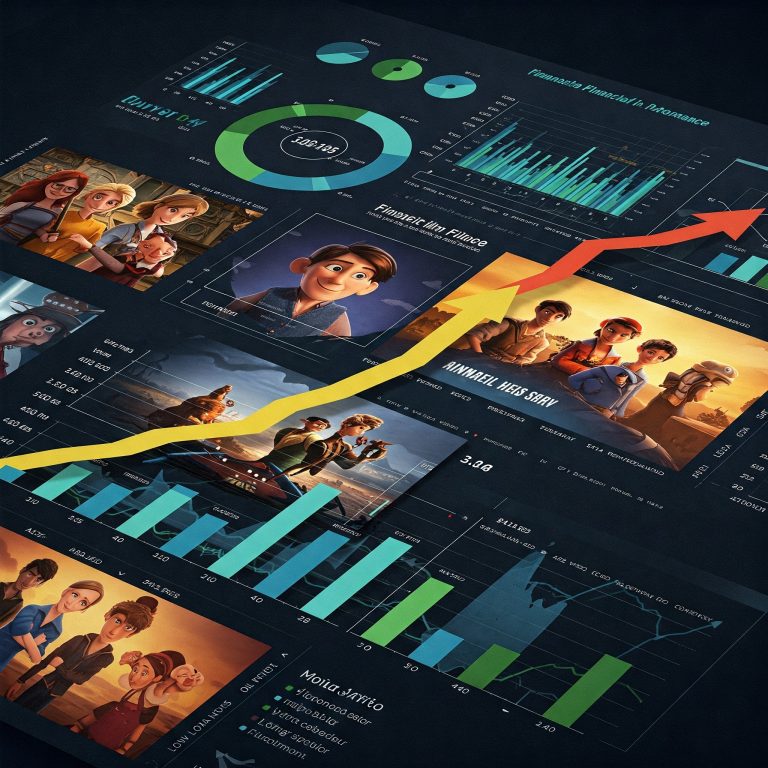
In this report, I analysed Pixar films data I found on Maven Analytics. I’ll walk through each dashboard page of the report. So viewers know what they’re looking at and why it matters when they view each dashboard screen.
Table of Contents
Introduction
Pixar Animation Studios has established itself as a global leader in animated filmmaking, renowned for combining technological innovation, compelling storytelling, and commercial success.
This report uses data curated by Eric Leung to provide a comprehensive overview of Pixar Animation Studios’ feature films.
The objective of this report is to analyze Pixar’s film portfolio quantitatively and qualitatively, assessing its financial performance, public and critical reception, and production strategies, to drive insights into the studio’s long-term success model.
Methodology
The report uses a dataset comprising key metrics from Pixar’s 28 feature films, including:
- Box office earnings
- Production budgets
- Awards and nominations
- Audience and critic scores
- Genre and thematic characteristics
- Directorial and creative leadership
Descriptive statistical methods and comparative analysis (original films vs. sequels) are applied to identify trends and correlations.
Tool: Power BI
You can view the full report here👇
Page 1: Pixar Films — Key Statistics Overview
This page provides a high-level snapshot of Pixar’s filmography from 1995 to 2024, summarizing the core metrics that define its cinematic journey:
- Total Films Released: 28
- Global Box Office Earnings: $17.04 billion
- Cumulative Production Budget: $4.4 billion
- Total Profit: $13 billion
- Return on Investment (ROI): 292%
- Academy Award Nominations: 40
- Academy Award Wins: 17
- Average IMDB Score: 7.54
- Average Runtime: 100.39 minutes
- Average Rotten Tomatoes Score: 88.4%
- Average Metacritic Score: 78.1
- Number of Key Contributors: 95 (directors, writers, etc.)
🟢 Insight:
Pixar has achieved a rare combination of commercial success (high ROI and profits) and critical acclaim (high ratings and awards) over nearly three decades.
Page 2: Box Office & Production Analysis
This page dives deep into the financial performance of individual Pixar films and broader trends over time.
- Box Office vs. Budget by Film: Top-grossing films include Incredibles 2, Finding Dory, and Toy Story 3.
- Sequel vs. Original Comparison: Sequels, on average, have higher box office returns compared to original films, justifying Pixar’s investment in franchise-building.
- ROI by Film: Films like Toy Story, Finding Nemo, and Inside Out show exceptionally high ROI — high earnings relative to budget.
- Trends Over Time (1995–2020): Both production budgets and box office earnings have trended upwards, reflecting Pixar’s growing scale and market influence.
- Earnings by Film Rating: PG-rated films tend to outperform G-rated films regarding box office earnings.
- Financial Performance Comparison of Films: The chart compares the average budget, ROI, and worldwide box office gross for various films. “Inside Out 2” leads in box office earnings. Several films share the highest average budget of $200,000,000, including Cars 2, Finding Dory, Incredibles 2, Inside Out 2, Lightyear, Monsters University, Toy Story 3, and Toy Story.Toy Story shows a particularly high RO.
🟢 Insight:
Pixar’s strategy of alternating originals and sequels has driven sustained financial growth, while PG ratings open doors to broader audience appeal.
Page 3: Awards & Industry Recognition
This page highlights Pixar’s accolades and critical recognition.
- Oscar Nominations by Film & Award Type:
• WALL-E, Up, Toy Story 3, and Finding Nemo secured nominations across Best Animated Feature, Original Score, and even Best Picture (Toy Story 3).
- Oscar Wins by Film:
• Coco, Soul, The Incredibles, and Inside Out are Pixar’s most decorated films.
- Awards by Film Rating: G-rated films like Finding Nemo and Coco have strong award-winning records.
- Top Contributors: Frequent contributors such as Pete Docter, Andrew Stanton, and John Lasseter played pivotal roles in Pixar’s award-winning success.
🟢 Insight:
Pixar’s commitment to storytelling excellence and innovation has translated into consistent Academy Award recognition, reinforcing its leadership in animation.
Page 4: Audience Ratings & Film Attributes
This page examines how audiences and critics responded to Pixar’s films and explores key film characteristics.
- Average Ratings (IMDB, Rotten Tomatoes, Metacritic) by Film:
• Top Rated Films: Coco, WALL-E, Inside Out, Toy Story
• These films consistently score high across audience (IMDB) and critic platforms (Rotten Tomatoes, Metacritic). - Genre Distribution: Most Pixar films’ top genres are Adventure(28), Animation(28),Computer animation(28) Comedy(21), and Fantasy(14), themes — demonstrating Pixar’s storytelling versatility.
- Average Runtime by Film: Most Pixar films fall between 90 to 118 minutes with Incredible 2 have longest running time(118) , maintaining a consistent, audience-friendly length.
🟢 Insight:
Pixar’s cross-generational appeal is reflected in both high audience ratings and strong critical reception, supported by consistent genre blending and runtime optimization.
Final Insights & Takeaways
- Pixar has balanced originality and franchise building to maintain financial strength
- The studio enjoys critical acclaim, with sustained Academy Award success
- Audience response remains consistently strong across platforms and decades
- Pixar’s unique storytelling formula — emotional depth, universal themes, and visual innovation — underpins its enduring success